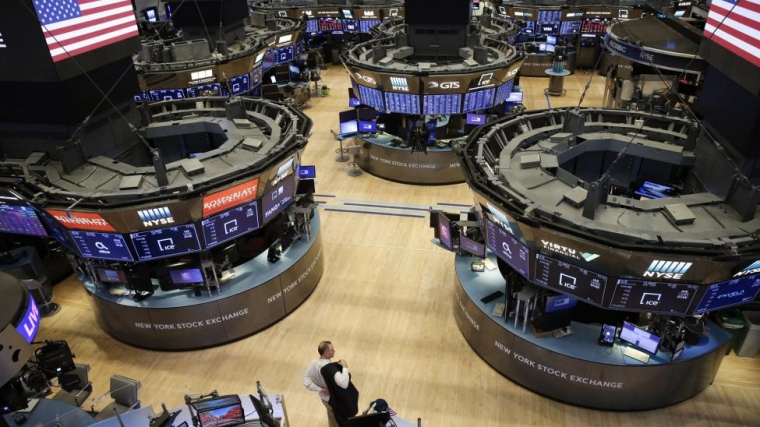
Risk assets are higher, driven by a surge in Chinese equities as the government encouraged a bull market, with the move spilling over into other markets. The USD is broadly weaker, while the NZD and AUD have pushed higher, although without much follow-through overnight.
Given the negative news headlines over the weekend we expected risk assets to begin the week on a soft note. That was the case with the NZD and AUD opening weaker, but after the Asia open, risk assets got a bid.
A front-page editorial in the Chinese state media-sponsored Securities Times said that fostering a “healthy” bull market after the pandemic is now more important to the economy than ever. This fuelled a further rally in Chinese equity markets, with the CSI300 index surging by 5.7% – its biggest rise since 2015 – taking its gain over the past five days to 14%. China’s 10-year bond rate broke up through 3%, its highest level since January, and increasing its spread to global rates, and driving a stronger CNY. USD/CNY is down 0.7% for the day to 7.0188, its lowest level since March.
The surge in Chinese equities seemed to add further fuel to the global equity market rally, seeing the Euro Stoxx Index close up 1.6%. The S&P500 opened strongly and is currently up 1.3%. While it looks like a liquidity-fuelled rally, there has been some fundamental support, with the US ISM non-manufacturing index blasting up nearly 12 points to reach a higher-than-expected 57.1 in June, a four-month high, continuing the trend of economic data positively surprising. The usual warning signals about the data need to be applied here – the survey captures a rate of change (not level) concept and the recent ramp-up in the spread of the virus could easily restrain any recovery in activity. The employment component of the index rose to 43.1, a below-50 rate consistent with firms still shedding staff.
German factory orders were much softer than expected, with “only” a 10.4% rise in orders for May following the 37% slump over the prior two months, suggesting plenty more wood to chop to get the economic firing up again.
On COVID19 the newsflow has remained negative. The rolling 7-day average for new case numbers for the US continues to trend higher, hospitals are near full capacity in Texas and Florida and US deaths have now surpassed 130,000. New Jersey’s transmission rate (Rt) jumped to 1.03, a 10-week high. New waves of the virus are evident across the world spanning Tokyo, Iran and Israel. In Australia, the border between NSW and Victoria will close tonight for the first time in more than 100 years – involving monitoring 55 bridge, land and river crossings – after Victoria recorded 127 new cases of COVID19, its highest daily increase.
Never mind, the market has become de-sensitised to negative news on COVID19, and so that hasn’t got in the way of a rally in risk assets. In currency markets, the NZD broke up through 0.6550 early afternoon, but the June-high of 0.6584 was never seriously threatened, with the currency peaking out at 0.6566 within a couple of hours after the local close. There has been little movement overnight. AUD followed a similar pattern, finding resistance just under 0.6990. The NZD/AUD cross headed down to 0.9380 overnight but has since reversed course to be just above 0.94.
Against a broadly weak USD, EUR got up to 1.1345 overnight and has since retreated, but outperforming the NZD for the day, taking the cross just below 0.58. CAD, JPY and GBP have shown little movement against the USD.
The rates market has remained sleepy, relatively unresponsive to the rally in equities. The US Treasury 10-year rate has been tightly range-bound overnight and sits little changed from the NZ close around 0.69%.
NZ’s government and swaps curves showed modest steepening biases yesterday, with the 10-year NZGB up 4bps to 0.99% and the 10-year swap rate up 3bps to 0.79%, although trading conditions were very quiet. The RBNZ’s LSAP was well offered, going through mids and with decent cover in all lines. The steepening bias to the curve is expected to continue ahead of next week’s 2041 bond syndication.
In the day ahead, NZ’s Quarterly Survey of Business Opinion should pass without much reaction. It will likely show a recovery in its net confidence measure, but maybe not in its activity indicators, as the previous survey was conducted just before the country went into full lockdown in late March.
The RBA should keep policy unchanged as it continues to assess the shape of the recovery. Importantly, the bank will be looking to 23 July when the government is set to announce its plans for the JobKeeper wage subsidy, currently slated to end in September.

We welcome your comments below. If you are not already registered, please register to comment
Remember we welcome robust, respectful and insightful debate. We don't welcome abusive or defamatory comments and will de-register those repeatedly making such comments. Our current comment policy is here.